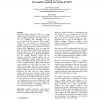Free Online Productivity Tools
i2Speak
i2Symbol
i2OCR
iTex2Img
iWeb2Print
iWeb2Shot
i2Type
iPdf2Split
iPdf2Merge
i2Bopomofo
i2Arabic
i2Style
i2Image
i2PDF
iLatex2Rtf
Sci2ools
IJHCI
2008
2008
Coupling the Users: The Benefits of Paired User Testing for iDTV
Interactive digital television (iDTV) is a social medium and must therefore be tested in a context as close to real life as possible. This explains why we saw the potential and importance for the involvement of real life couples in iDTV usability testing. We will describe an experiment that compares single user testing and co-participation testing with couples for the evaluation of several Flemish iDTV applications. First, we found that there was less probing needed by the facilitator to think out loud in the think aloud/co-participation method with couples than in the think aloud/single test user method. Secondly, couples did not encounter difficulties working together with the iDTV applications. Further, couples did not lose time by discussing irrelevant issues during the test session. A fourth finding is that couples detected more usability hits than single test users. The quality of comments, however, was the same in both conditions. 60 % of the comments consisted of intrinsic sug...
Couples | IJHCI 2008 | Test Session | Test Users |
| Added | 12 Dec 2010 |
| Updated | 12 Dec 2010 |
| Type | Journal |
| Year | 2008 |
| Where | IJHCI |
| Authors | Tara Shrimpton-Smith, Bieke Zaman, David Geerts |
Comments (0)

